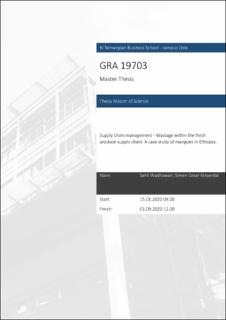| dc.description.abstract | In recent years, there has been an increasing focus around the term sustainability
and its practical implications. One major component in this development is the
“accelerated productivity in food chains”. The relevance of our thesis will be
aligned with this reasoning and aims at becoming a significant contribution to the
field of practical sustainable implementation. The research question we will be
answering is: How can the theory of supply chain management be applied to reduce
the wastage in the mango supply chain in Ethiopia, in particular the post-harvest
handling of mangoes?
A literature review was conducted to understand why and how supply chain
management (SCM) can reduce wastage in the Ethiopian fresh produce supply
chain (FPSC). During this process relevant components were identified and
followed up by finding an appropriate framework for analysing the case. The
reasoning for choosing Trieneken´s framework (2011) is that it enables us to gain
a comprehensive and wider scope which captures the context that is present. The
framework is used to; 1) assess constraints, 2) analyse the chain and 3) examine the
upgrading possibilities to improve the performance of the supply chain. Thus,
ultimately leading to a reduction in the post-harvest losses of mangoes in Ethiopia.
A qualitative research strategy has been used, which is supported by an abductive
approach. The research design chosen is a case study which has given in-depth
information within the research. Overall, the findings are similar to the literature;
pinpointing how excessive handling, exploitation of other actors and inadequate
infrastructure are key factors for the wastage. However, we argue how these factors
are present not as a result of the smallholders, but because of their surrounding
circumstances and lack of successful government intervention. We suggest that the
actors can improve their performance by altering the smaller actors` position -
horizontally and vertically, and utilize the reasoning behind best practice SCM -
where transparency, collaboration and value sharing are present. As the smaller
actors have limited possibility to alter their position in the market configuration, we
conclude and recommend the formation of collaborative agreements horizontally -
through cooperatives, or forming relationships with global actors to improve their
vertical position. Lastly, to truly improve the performance of the local chains,
incentives throughout the whole chain need to be initiated between the actors. | en_US |

